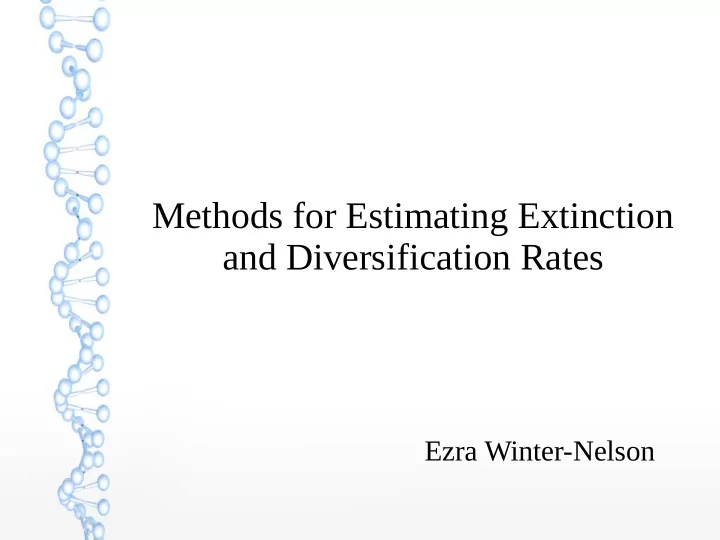

Methods for Estimating Extinction and Diversification Rates Ezra Winter-Nelson
Motivation ● Phylogenetic estimation ● How do we gauge a model’s applicability at evolutionary timescales? Fossil records – Environmental events –
Current Methods ● BAMM (Bayesian) ● MEDUSA (Maximum Likelihood) ● TreePar (Maximum Likelihood) ● CoMET (Bayesian)
Considerations ● Molecular Clock Strict – Relaxed – ● Extinction Type Global – Lineage-Specific – Molecular Ecology Volume 23, Issue 24, pages 5947-5965, 30 OCT 2014 DOI: 10.1111/mec.12953 http://onlinelibrary.wiley.com/doi/10.1111/mec.12953/full#mec12953-fig-0002
Goals ● Comprehensive exploration of the field Pros/Cons of each method – Major roadblocks – ● State of the field going forward New directions – Predictive efficacy –
References Ho, S. Y. W. and Duchêne, S. (2014), Molecular-clock methods for estimating evolutionary rates and timescales. Mol Ecol, 23: 5947– 5965. doi:10.1111/mec.12953 Laurent, S., Robinson-Rechavi, M., Salamin, N. Are we able to detect mass extinction events using phylogenies? bioRxiv 004572; doi: https://doi.org/10.1101/004572 Laurent, S./ Robinson-Rechavi, M., Salamin, N. (2015). Detecting patterns of species diversification in the presence of both rate shifts and mass extinctions. BMC Evolutionary Biology, 15:157. doi: 10.1186/s12862-015-0432-z. May, M. R., Höhna, S. and Moore, B. R. (2016). A Bayesian approach for detecting the impact of mass-extinction events on molecular phylogenies when rates of lineage diversification may vary. Methods Ecol Evol, 7: 947–959. doi:10.1111/2041-210X.12563. May, M. R., & Moore, B. R. (2016). How Well Can We Detect Lineage-Specific Diversification-Rate Shifts? A Simulation Study of Sequential AIC Methods. Systematic Biology , 65 (6), 1076–1084. http://doi.org/10.1093/sysbio/syw026 Vitti, J.J., Grossman, S.R., and Sabeti, P.C. (2013). Detecting natural selection in genomic data. Annual Review of Genetics, 47, 97–120.
Recommend
More recommend